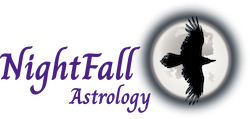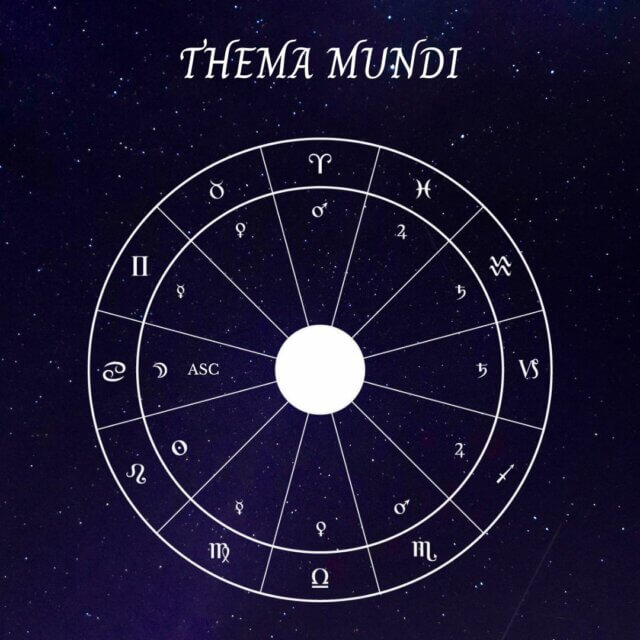No products in the basket.
Unveiling the Cosmos: A Deep Dive into the Thema Mundi – The Natal Chart of the World
Dear NightFall Astrology readers,
Delving into the heart of the Hellenistic tradition, we encounter a concept as profound as it is intricate: the “Thema Mundi”. This phrase is a Latin translation of the Greek phrase “kosmou genesis”, and both mean “Nativity of the Cosmos” or “Birth Chart of the World”, names as grandiose as the concept they represent.
Conceptualised as a cosmic blueprint, the Thema Mundi crystallises the state of the universe at the precise moment of its creation, capturing the celestial dance of the planets and the astrological signs in a moment of perfect harmony. Each planet, each sign, is meticulously plotted, reflecting a divine order and offering a cosmic narrative that has echoed throughout millennia.
This celestial narrative provides an emblematic map, bridging the earthly and the divine, the known and the mysterious. The Thema Mundi invites us into a universe where astrology and philosophy intertwine, where scientific observation meets spiritual insight. It paints a picture of the cosmos not just as a physical reality, but as a metaphysical realm, pulsating with hidden meanings and divine messages.
A cornerstone of Hellenistic astrology, the Thema Mundi is much more than an archaic concept; it continues to be a beacon of knowledge, guiding us in our continuing exploration of the universe and our place within it. This mythical horoscope offers an enduring testament to the human endeavour to seek understanding and connection with the cosmos, a quest as timeless as the celestial bodies it seeks to comprehend.
This article explores the historical and philosophical context, structure, significance, and interpretations of the Thema Mundi and its lasting influence on astrological practices.
I. The Structure of Thema Mundi
At its core, the Thema Mundi embodies the philosophy of “as above, so below”. It translates the cosmic narrative into tangible and practical astrological concepts. It explains the traditional rulerships of signs by planets, planetary joys, aspects, and numerous other doctrines.
A unique feature of this chart is that each of the twelve houses starts with a whole sign of the zodiac, beginning with Cancer in the Ascendant. The planets are positioned according to the Chaldean order, their ancient sequence of apparent speed and distance from Earth (from slowest and farthest to fastest and closest to the Earth). This order is as follows: Saturn, Jupiter, Mars, Sun, Venus, Mercury, and Moon. This particular order draws its name from the Chaldeans, an ancient civilisation celebrated for their profound contributions to the fields of astronomy and astrology.
In the Thema Mundi, once we reach Aquarius, we restart the sequence of the Chaldean order, and we find 2 signs of domicile for each of the planets apart from the luminaries (the Sun and the Moon). This makes one of the primary teachings of the Thema Mundi the introduction of essential dignities, a foundational system in astrology determining a planet’s strength or weakness within a specific sign.
For instance, Mars in Aries demonstrates the fiery, assertive energy that naturally belongs to Mars, hence its rulership over Aries. It’s also the 10th sign/house in the Thema Mundi — the (visible) peak point in the sky that a planet reaches in its diurnal motion — thus representing leadership and power due to one’s career/occupation/vocation.
Moreover, the concept of “planetary joys” directly stems from the Thema Mundi. This is the notion that each planet has a “happy place” or a house where its qualities are most suitably expressed. The Sun’s joy in the ninth house signifies the pursuit of higher knowledge and truth, while the Moon’s joy in the third house represents the constant flux of everyday communication and short journeys.
Another crucial application of the Thema Mundi lies in understanding the nature of aspects, defined as the angular relationships between planets or points on the celestial sphere. The inherent meanings of the astrological aspects are revealed by observing the relationships between the signs and planets in the Thema Mundi.
For example, oppositions have the nature of Saturn, as the aspect reflects the relationship between Leo (the Sun’s domicile) and Aquarius (Saturn’s domicile) on the one hand, and the relationship between Cancer (the Moon’s domicile) and Capricorn (Saturn’s other domicile) on the other, in the Thema Mundi.
Furthermore, the Thema Mundi plays a pivotal role in conceptualising the twelve astrological houses, reflecting various areas of human life. Each house is linked to a sign, revealing the essential nature of its affairs. For instance, the first house (Ascendant) corresponds with Cancer, the sign of nurturing, home, and the mother, indicating the beginnings of life, self-identity, and physical appearance.
Hence, the Thema Mundi is a tool that enhances our understanding of astrological aspects. It allows astrologers to delve into the roots of these planetary relationships, illuminating the subtle dynamics that underpin astrological interpretation. Through this lens, the Thema Mundi transcends its function as a cosmic map and becomes an indispensable guide to decoding the symbolic dance of the planets.
A question that frequently arises is why Cancer was chosen as the rising sign in the Thema Mundi. The rationale behind this selection can be traced back to two pieces of ancient astrological lore.
The first lore originates from late Mesopotamian or early Hellenistic astrologers who proposed a belief that the alignment of all planets in the signs of Cancer and Capricorn represented the periodic creation and destruction of the world. This belief may have stemmed from the seasonal correlations of these signs: Cancer coincides with the hottest part of the year in the northern hemisphere, thus associated with fire and creation, while Capricorn, in contrast, aligns with the winter months, and thus linked to the coldness of water and the concept of destruction.
The second rationale links to the ancient Egyptian civilisation. Their annual calendar was initiated by the heliacal rising of Sirius, the brightest star in the night sky, which happened during the summer months when Cancer was rising over the eastern horizon. The ascendancy of Sirius in Cancer marked the commencement of the annual flooding of the Nile, a pivotal event that signified rebirth and renewal. This cultural and astrological event may explain why Cancer was assigned such a significant role in the Thema Mundi, symbolising a cosmic new beginning.
II. Divinity of the Cosmos: Delving into the Philosophical Depth of the Thema Mundi
While most astrologers refer to the Thema Mundi as the nativity of the cosmos, Antiochus’s reference to it as the “nativity of god” (theou geneseos) offers a window into the philosophical underpinnings of early Hellenistic astrologers.
Certain philosophical schools of the era viewed the cosmos as a divine entity, illuminating the theological foundations upon which the Thema Mundi was built. In the Timaeus, the seminal work of the classical philosopher Plato, the cosmos is portrayed as a living creature, gifted with soul and intelligence. This philosophical tenet was further expanded by the Stoics who developed a pantheistic philosophy, presenting the cosmos as a sentient, divine being. According to this view, the sensible world is the body of the cosmos, inseparably infused with its invisible soul that binds everything together.
“The Stoics propose that God is intertwined with matter, permeating all of it, thus moulding it, structuring it, and shaping it into the world,” suggests a perspective that underscores the divinity inherent in the cosmos. The term “cosmos,” often associated with the Thema Mundi, was frequently used by the Stoics to reference God.
Diogenes Laertius, the biographer of the Greek philosophers, cites the Stoic usage of “world” or “kosmos” to refer to the divine entity, the peculiarly qualified individual composed of all substance, both destructible and ingenerable.
This concept also finds resonance in the Corpus Hermeticum, which emphasises the cosmos’s divinity. The Hermeticum illustrates the cosmos, this great God, as the image of something greater, preserving the order and will of the Father and embodying the abundance of life. It suggests that nothing within the cosmos is void of life – every part of it lives, has lived, or will live.
The Thema Mundi’s deep philosophical and religious significance might stem from its portrayal as the birth chart of the cosmos. It provided early Hellenistic astrologers with valuable insights into the universe’s inner workings, development, and the divine essence pervading it all.
By scrutinising the cosmos’s hypothetical birth chart, the Thema Mundi transcends its astrological construct to offer potential glimpses into the divine itself. The Thema Mundi, hence, isn’t merely an astrological tool but a philosophical framework unveiling the cosmos’s sacred unity and divine life force.
Thank you for reading.
Fuel my caffeine addiction and spark my productivity by clicking that ‘Buy me a coffee’ button—because nothing says ‘I love this blog’ like a hot cup of java!
Buy Me a Coffee
Your Astrologer – Theodora NightFall ~
Your next 4 steps (they’re all essential but non-cumulative):
Follow me on Facebook & Instagram!
Subscribe to my free newsletter, “NightFall Insiders”, the place where the most potent magicK happens, and get my daily & weekly horoscopes, exclusive articles, updates, and special offers delivered directly to your inbox!
Purchase one of my super concise & accurate mini-readings that will answer your most pressing Astro questions within 5 days max!
Book a LIVE Astro consultation with me!












